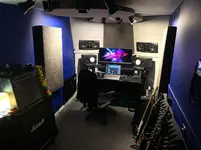Twiddler
of the Nurgulated Plupper.
I joined this forum today due to being profoundly unsatisfied by what I made yesterday and listened to earler.
One of the things I have read several times today is that the speakers you use to listen to your work should be really good quality, flat response studio monitors.
Since relocating from the uk I've been using a pair of JVC SP-UXD88s, which sound great in the control room. They didn't sound very good in the old property and I rarely used them there, but now that we have a dedicated control room they've been hanging from the ceiling and doing a good job. Or so I thought...
I can't seem to find any frequency response curves for them online and even though what I produced sounds fantastic in the studio, it sounds pretty awful outside of it. It's so quiet and lifeless.
I've been thinking about upgrading to a pair or KRK Rokits for a while now and should have a budget to do so in a few months, maybe sooner if we sell a few more songs!
There is another pair of speakers in the studio that are somewhat home-made. They are a pair of big wooden speaker cabinets from Russia that a second hand hifi shop had thrown in a skip and were salvaged by one of our chaps. A bass, a mid and a tweeter are in each, cannibalised from old car stereos. The whole thing was put together by another of our chaps, who is sadly no longer with us. These cabs sound pretty bassy and muddy. I only really use them to check what some really big bassy cabs might sound like with our music in them. They would probably work quite well in a small nightclub.
So tell me more about monitoring. Are the JVCs any good? Why do the JVCs now sound great but they didn't when we lived in Devon? Are the Rokits as good as people say or is there something better for a similar price?
There doesn't seem to be a dedicated section to monitoring in the forums so thought I'd post this here. Hope that's ok.
One of the things I have read several times today is that the speakers you use to listen to your work should be really good quality, flat response studio monitors.
Since relocating from the uk I've been using a pair of JVC SP-UXD88s, which sound great in the control room. They didn't sound very good in the old property and I rarely used them there, but now that we have a dedicated control room they've been hanging from the ceiling and doing a good job. Or so I thought...
I can't seem to find any frequency response curves for them online and even though what I produced sounds fantastic in the studio, it sounds pretty awful outside of it. It's so quiet and lifeless.
I've been thinking about upgrading to a pair or KRK Rokits for a while now and should have a budget to do so in a few months, maybe sooner if we sell a few more songs!
There is another pair of speakers in the studio that are somewhat home-made. They are a pair of big wooden speaker cabinets from Russia that a second hand hifi shop had thrown in a skip and were salvaged by one of our chaps. A bass, a mid and a tweeter are in each, cannibalised from old car stereos. The whole thing was put together by another of our chaps, who is sadly no longer with us. These cabs sound pretty bassy and muddy. I only really use them to check what some really big bassy cabs might sound like with our music in them. They would probably work quite well in a small nightclub.
So tell me more about monitoring. Are the JVCs any good? Why do the JVCs now sound great but they didn't when we lived in Devon? Are the Rokits as good as people say or is there something better for a similar price?
There doesn't seem to be a dedicated section to monitoring in the forums so thought I'd post this here. Hope that's ok.


